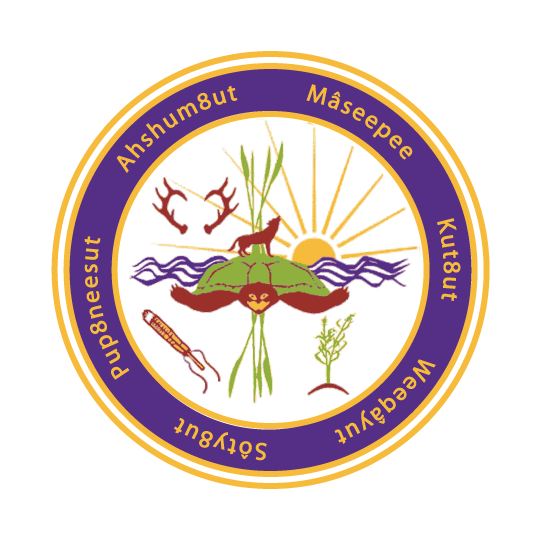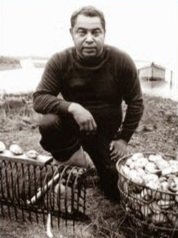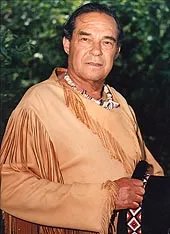Vernon 'Silent Drum' Lopez
The soft spoken unassuming leader brought a quiet resolve to the tribal agenda. Like many Mashpeeians, "Bunny" was a nickname given to him by an aunt and most never knew his given name. The thoughtful Chief focused on issues that influenced the future of the Tribe. He was part of the leadership that guided us through the final phase of the very emotional recognition process and the membership is grateful for his steady hand. He said education and healthcare are central to the destiny of the Mashpee Wampanoag. Chief Silent Drum passed on in 2023 at 100 years of age.
Earl 'Flying Eagle' Mills, Sr., Chief
A traditionalist but also a modern chief with a diverse background, the gregarious Mills brought education, and a variety of outside experiences to his leadership role. A historian and expert on "all things Wampanoag", Mills epitomized the vast diversity of the Mashpee Wampanoag whose survival skills required an adeptness and balance between walking in the outside world while protecting and preserving unique tribal traditions. A renowned chef of traditional foods, a teacher, and entrepreneur, Mills continues to educate tribal members and friends about the significance of Native tradition in today's world.
Vernon 'Sly Fox' Pocknett, Chief
Always at the center of the storm, Vernon Pocknett partnered with Tribal Chairman to keep the pressure on for the fledging Mashpee Wampanoag. Whether the land suit, fishing rights, or the quest for recognition, "Sly Fox" was in the mix. Outspoken and unabashed, Vernon was a sharp contrast to many Mashpee leaders who would sooner ignore you than confront you. He would set you straight in a hurry. A master fisherman and hunter in the Pocknett tradition, the Chief would take tribal children on camping trips and excursions to remind each generation of their unique heritage and valued place in the world.
Blind Joe Amos
The ordained Mashpee Wampanoag Indian minister was a pastor with substantial credentials, a reputation for great sermons and a propensity to fiddle. In 1834 Amos joined William Apes, a Pequot minister and led an insurrection against Whites coming to Mashpee and taking the plentiful and valuable wood. The State of Massachusetts called the peaceful removal of wood from the carts a "riot". The Mashpee began the first phase of true self governance thanks to Amos. The relationship with outsiders would never be quite right, but the intelligent and wise Amos initiated the tradition of questioning the insensitivity of those who were unfamiliar with the ways of the People of the First Light.
Steven A. 'Happy' Peters
Steven Peters was a prominent Mashpee Wampanoag whose political prowess as a Selectman from 1927-1954 helped bring national prominence to the little village. Peters plan to modernize Mashpee with electricity was very controversial at the time. Peters pressed on anyway and won. As a Roosevelt Democrat, and the friend of Governors, Mayors, and Joe Kennedy, he brought patronage to Mashpee persuading hardcore Republicans to become Democrats. At election time, the Mashpee vote was so small and accurate; it became the bellwether for the rest of the nation. Peters' sincere love for his people was reflected in his popularity. But his influence as a parent was such that seven of his eight children continued his legacy by serving the Wampanoag, the nation or the town of Mashpee as elected or appointed officials. His approval would be punctuated with, "My stars!"
John A. Peters
John A. Peters left a lucrative construction business to become the spiritual leader of the Wampanoag Nation in the 70's. Peters learned medicine from Billy James, his wife Barbara's uncle, and became a prominent Native American spiritualist and ambassador for American Indians throughout the world. 'Slow Turtle' was also the first Executive Director of the Massachusetts Commission of Indian Affairs. Despite the origins of his paycheck, Peters was famous for reminding his employers of the demise of his people. He successfully initiated Congressional legislation to protect Native children in the adoption process and protected sacred American Indian rituals. 'Slow Turtle' became a living symbol of the Mashpee Wampanoag identity and despite his world celebrity status he was a Mashpeeian first, loved dearly by his family and tribe. When he died in 1997, "Slow Turtle's" obituary was featured in Time Magazine and The New York Times. You could see him throwing his head back laughing, saying, "Are they talking about me?"
Gertrude 'Princess Evening Star' Haynes Aikens
A spunky and aggressive Wampanoag woman, Gert Aikens possessed an entrepreneurial spirit yet to be matched. She had a very fancy gift shop in South Mashpee on her homestead and held week-long "Indian Programs" in late August during the '50's and '60's. Her infamous tee-pee greeting the curious who visited the little compound to be intrigued by her articulate story telling about the "Greeters of the Pilgrims" and her colorful demeanor is still talked about. From another prominent Mashpee family, Gertrude Haynes Aikens was present at events everywhere in New England as a constant reminder that the Mashpee Wampanoag were alive and well.
Solomon Attaquin
A fascinating story of determination, Solomon Attaquin defied all stereotypes. Born in 1810, Attaquin was literate, an unusual accomplishment for Natives in the era. He was a sea cook at age 12 and a whaler when he turned 14. Attaquin lobbied the Massachusetts Legislature on behalf of Mashpee and was elected one of the districts first selectman. When Mashpee became a town, he was also the first postmaster. An entrepreneur as well, Attaquin built a hotel that was his namesake across from the Mill pond and that hosted many famous politicians, actors and sportsmen. The Attaquin was a proud fixture in Mashpee as was its owner and his family.
Russell M. 'Fast Turtle' Peters
The first Tribal Chairman during the early 70's and the longest serving, the shrewd leader and a dozen Mashpee Wampanoag filed the famous land suit to reclaim land taken and developed illegally. Peters also initiated the quest for recognition that was achieved in 2007 after his death in 2002. Like many Mashpee Wampanoag men, Peters was a war veteran. He was a college educated executive and received a Master's Degree from Harvard. Well known and respected in Indian country, he authored numerous books abut Old Mashpee and its unique traditions. And like all of the tribes' leaders, he was passionate about his people.
Ambrose Pells
Mr. Ambrose was what many called, the backbone of the Mashpee Tribe during his life. He was a fisherman, and natural Indian man, proud of his heritage. Always busy, caring for the Old Indian Church, with coats and white paint that probably was responsible for its survival since the 1600's. He made wood markers for graves of those in need and kept the grounds neat. Ambrose had a little black car which he kept running, skilled in the art of making do with what he had. Whenever a Mashpee family needed help, the little car would appear with something of substance to get us over the hard times. He was also very involved in the politics of Mashpee as a member of the elder men's council and deeply loved.
Ferdinand & Emma Oakley Mills
The Mills' were a prominent couple who influenced the Tribe politically and traditionally for half a century. Ferdinand was a Selectman for many years and was a hunting and fishing guide whose expertise was renowned. Many inside and outside the Tribe sought his council concerning the proper way to prepare and preserve fish and game. "Miss Emma" was the town Tax Collector for over thirty years and was very active in town politics. She was a stickler for details, vocals, and unafraid of challenging whatever she thought was wrong or improper. While the Mills' and Peters' were political adversaries, they shared the pain of loosing sons Lincoln and Steven, Jr. in World War II. Emma Mills and Clara Peters were often pictured together as Gold Star Mothers, symbols of the strength and love they had for their warrior sons.
Eben Queppish
The handsome Wampanoag is credited with reviving tribal culture and the Confederacy in the 1920's along with Nelson Simon, a Carlisle Indian School graduate. Under his leadership, The People of the First Light returned to wearing regalia, participated in Pau Wau, and the use of herbs. Queppish brought renewed focus to the Indian Town of Mashpee in the New Bedford Times and the Boston Post. Queppish was used to the publicity; after all, he was the original Native American in Bill Cody's "Wild West Show." When he died in 1933, hundreds of Wampanoag attended his funeral at the Old Indian Meeting House to pay final tribute to their leader.
Hazel 'Silver Fox' Peters Oakley
Hazel was a very accurate symbol of Mashpee Wampanoag women. A beauty that was self-depreciating, smart, and sassy, she possessed a very candid, dry humor that would repeatedly catch you off-guard. She was the Tribe's faithful diplomat. As one of the original land suit petitioners, Hazel Oakley fought hard for what belonged to her people. She continued the battle as the Tribe's historian in the quest for recognition. Respected in Indian Country, and loved by Mashpeeians, Hazel is smiling at us now, remarking in her Mashpee drawl, "Welllllllsah, it's about time!
Clara Louise 'Dancing Pony' Peters Keliinui
Young Clara would continue the tradition of drawing attention to the "Little Indian Town" on Cape Cod. Because she would be labeled a "first" in many political and athletic genres during the '50's and '60's, Clara would serve was the first woman selectman in Mashpee and Chief of Police, which were posts her father held. Sophisticated and fashionable, she was often featured in national magazines and periodicals. She was considered a professional golfer and beat most men she played. The Clara Louise Keliinui Memorial Golf Classic was established by her daughter Trish, in her memory as a testament to extraordinary talent, political prowess, and good old Mashpee savvy.
Ellsworth Oakley, "Drifting Goose"
Supreme Sachem of the Wampanoag Nation
Ellsworth Oakley Jr., holds the distinction of being the Wampanoag Nation's longest serving traditional leader as Supreme Sachem. "Drifting Goose" took the helm of leadership in 1975 and continues preside in that capacity today. Oakley has an intriguing life story. He served in the Army as a paratrooper and even joined the circus. But most importantly he was a traditionalist. Oakley engaged in the sweats used in ancient times and taught Tribal members these and other important rituals. On the modern front he was an active member of the American Indian Movement. He was the first President of the Boston Indian Council and a well known Indian activist who fought for Indian rights across the country. "Drifting Goose" is a Mashpee Wampanoag phenomenon and we are proud of his continued service to our people.
Tom Mingo
It was a rare sight to see Tom Mingo out of fishing or hunting gear. The striking Indian was one of the master fisherman and gamesman in the Tribe. Mingo was a member of a prominent Wampanoag family. He was also the Rivers keeper for Camp Farley between 1920-1950; Mingo guarded the Mashpee River's treasure, the trout. Boston attorney James Farley, a high ranking member of the Roosevelt administration, leased a significant portion of the river and Mingo was hired to watch over it and keep poachers out. Mingo took many famous men on excursions with his friend Farley. She shared many afternoons with fellow Mashpee Wampanoag and exchanged stories of gaming and good times. A quiet man, Tom Mingo was nonetheless a Wampanoag legend.
Mabel ' Nakoomis' Pocknett Avant
One of the most revered elders of the Mashpee Wampanoag, Mable Avant, was a modern woman Sachem who taught young and old about tribal rituals, foods, traditions, and the importance of honoring the earth. Everyone loved to go camping with her. Miss Mable was also quite a poet who wrote extensively about her beloved Mashpee. Always involved politically, the independent Avant would listen to outsiders who would come to town meetings with precarious schemes to dupe Mashpee in some way. She would reveal the outcome of the plan, and admonish the person as the culprit scurried away to the howling delight of the Wampanoag audience.
Billy 'High Eagle' James
Billy James was a very prominent Wampanoag man. His vast knowledge of herbs and spirituality were handed down to him by his elders. He, in turn, shared his knowledge with the young men of the tribe who were interested in preserving the culture during the '40's and for decades thereafter. He is credited with helping to preserve the culture of the ancient Wampanoag Tribe and he mentored Slow Turtle, who became the renowned Supreme Medicine Man of the Wampanoag Nation.
Amanda Stella Gardner Hicks
"Miss Stella" probably invented the extended family because she lovingly watched over Mashpee children in the spirit of "it takes a village to raise a child." As a school committee member for many years, she was a fixture in the education process. Like many Mashpee Wampanoag women, she had a large family of her own, but she took the time and interest in the youth of Mashpee. If she caught them skipping school, writing on the walls, or other mischief, you could depend on a good scolding about the importance of attending school. She usually ended with, "I won't tell your mother this time, so you'd better not do this again." She had a lovely singing voice and served as the church soloist. She sang at weddings, funerals, and parties. Her ever present smile was infectious, but more importantly she was loved by everyone.
Curtis Frye
As long as there was a Police Department in Mashpee, it was run by Natives. In the "Old Indian Town", the inhabitants governed themselves. But when the Wampanoag lost political control in the mid 1970's, the Natives lost governing authority. That occurred everywhere but in the Mashpee Police Department where the former Deputy Chief, Curtis Frye took the reigns and held on from 1981-1994. In true Mashpee form, Curtis did not fit the mold. The Frye clan is known for being attractive, charming, and friendly. "The nicest guy in the world", as Curtis Frye is known, led to the town's last bastion of authority for the Mashpee Wampanoag. To this day when you see Curt, it"s hard to believe he was Mashpee's last Native Top Cop.
















